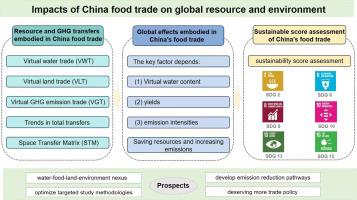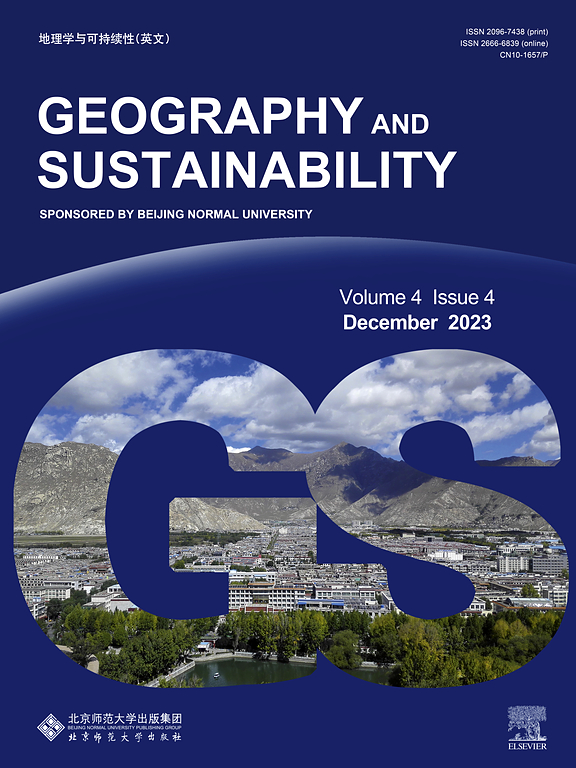中国食品贸易对全球资源与环境的影响:一个可持续发展的评估
IF 8
1区 环境科学与生态学
Q1 GEOGRAPHY, PHYSICAL
引用次数: 0
摘要
在满足中国日益增长的粮食需求的同时,保障资源和环境的长期发展,是本世纪可持续粮食系统面临的重大挑战。中国粮食进口加速对全球资源配置和环境发展具有深远影响。因此,关于中国食品贸易资源环境影响的详细信息对于设计有效的促进环境缓解和资源保护的政策是必不可少的。研究估算了虚拟水交易、虚拟土地交易和虚拟温室气体排放交易在中国食品贸易中的空间转移。研究结果表明,中国食品贸易中体现的VWT、VLT和VGT转移年增长率分别为10.4%、9.8%和15.2%。值得一提的是,虚拟水进口(VWI)和虚拟土地进口(VLI)分别为全球节约了119.5 × 109m3的水资源和29.5 Mha的土地资源,但虚拟温室气体排放进口(VGI)却增加了全球13mt CO2-eq的温室气体排放。中国粮食进口对全球粮食可持续性的不同影响源于虚拟含水量、产量和排放强度的变化。此外,排名前15位的进口国在可持续性得分上存在显著差异,这表明中国的食品贸易对全球粮食系统可持续性的深化做出了贡献。这项研究强调需要采取多方面的方法,考虑粮食贸易的各种环境影响。因此,鼓励中国将资源和环境保护的好处充分纳入其可持续粮食贸易战略,重组粮食体系,以确保其庞大人口的长期营养。本文章由计算机程序翻译,如有差异,请以英文原文为准。

Impacts of China food trade on global resource and environment: A sustainable development assessment
Meeting China’s burgeoning food demand while safeguarding the resources and environmental long-term development is a critical challenge for the sustainable food systems of this century. China’s accelerated food imports have far-reaching implications for global resource allocation and environmental development. Hence, detailed information regarding China’s food trade resource-environmental impacts is imperative for the design of effective policies that promote environmental mitigation and resource conservation. This study estimated the spatial transfers of virtual water trade (VWT), virtual land trade (VLT), and virtual GHG emission trade (VGT) embodied in China’s food trade. Findings indicate that the VWT, VLT, and VGT transfers embodied in China’s food trade increased by 10.4 %, 9.8 %, and 15.2 % annually. It is more important to mention that virtual water import (VWI) and virtual land import (VLI) saved 119.5 × 109m3 of global water resources and 29.5 Mha of land resources, respectively, but virtual GHG emission import (VGI) increased global 13 Mt CO2-eq GHG emissions. The divergent impacts of China’s food import on global food sustainability stem from variations in virtual water content, yields and emission intensities. Moreover, significant differences in sustainability scores were found among the top 15 importing countries, indicating that China’s food trade contributes to the deepening of global food system sustainability. This study highlights the need for a multifaceted approach that considers the various environmental impacts of food trade. China is therefore encouraged to fully integrate the benefits of resource and environmental conservation into its sustainable food trade strategy, restructuring the food system to ensure the long-term nourishment of its large population.
求助全文
通过发布文献求助,成功后即可免费获取论文全文。
去求助
来源期刊

Geography and Sustainability
Social Sciences-Geography, Planning and Development
CiteScore
16.70
自引率
3.10%
发文量
32
审稿时长
41 days
期刊介绍:
Geography and Sustainability serves as a central hub for interdisciplinary research and education aimed at promoting sustainable development from an integrated geography perspective. By bridging natural and human sciences, the journal fosters broader analysis and innovative thinking on global and regional sustainability issues.
Geography and Sustainability welcomes original, high-quality research articles, review articles, short communications, technical comments, perspective articles and editorials on the following themes:
Geographical Processes: Interactions with and between water, soil, atmosphere and the biosphere and their spatio-temporal variations;
Human-Environmental Systems: Interactions between humans and the environment, resilience of socio-ecological systems and vulnerability;
Ecosystem Services and Human Wellbeing: Ecosystem structure, processes, services and their linkages with human wellbeing;
Sustainable Development: Theory, practice and critical challenges in sustainable development.
 求助内容:
求助内容: 应助结果提醒方式:
应助结果提醒方式:


